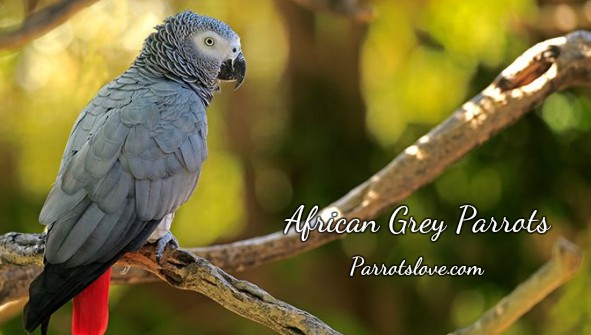
The amazing animals that we have come to understand as African Greys actually include two species of parrots–Grey & Timneh Parrots (Psittacus erithacus and Psittacus timneh).
African Greys are highly smart with entertaining personalities, making very famous companions. However, both species have been unfortunately threatened by deforestation and extensive trapping for wild bird trade.
Nesting close to the tops of forest trees, gregarious Greys create big communal flocks of up to 1000 people, while Timneh Parrots collect a few dozen in much smaller flocks.
Both species are known to mimic other birds and mammals ‘ calls, as well as to let out a range of whistles, squawks, shrieks, and shouts while in rest and flight.
They Are The Smartest Species Of Birds
African Grey Parrots are not only one of the most famous pet bird species, but also one of the most smart.
In latest years, researchers around the globe have performed a lot of studies on the mental ability of African Grey parrots. The most popular example of this is the work with her renowned African Grey, Alex, by Dr. Irene Pepperberg.
Using Alex and other African Greys in communication-centered study studies, she was able to demonstrate that not only can African Grey parrots learn a tremendous quantity of human words, they can learn to use them in context to interact with their owners.
It has been said that these amazing birds have a 5-year-old human child’s mental and emotional capabilities.
There’s More Than One Kind
While all kinds of African Grey parrots look comparable, this beloved bird actually has two different kinds and a few lesser-known subspecies. The Congo African Grey is the most popular and frequent. The Congo African Grey is African Grey’s biggest parrot, sporting in its plumage a lighter gray color and a strong black beak.
The second most prevalent form is the Timneh African Grey, which in 2012 was acknowledged as an individual species. The Timneh African Grey is slightly lower than the Congo, with darker colors on its fur.
Another defining feature of the Timneh Grey is that instead of a black one it has a horn-colored upper mandible. Despite their differences, these two kinds of African Grey parrots create great animals, and they are both equally smart.
Upper mandible rather than black mandible. Despite their differences, these two kinds of African Grey parrots create great animals, and they are both equally smart.
They can live for a long time
African Grey parrots have been known to live in captivity for up to 80 years, so it is essential for those who adopt them to commit to living with a bird for a lifetime.
African Grey parrots are too emotionally vulnerable to be able to manage being bounced from owner to owner, but unfortunately many of them have multiple homes throughout their lives because individuals rush to adopt them without thinking through them completely.
By assisting inform individuals about African Grey ownership and making sure you set a nice example for bird owners who might be interested in adopting such a parrot, you can assist put an end to circumstances like this.
Take Care for an African Grey Parrot Can Be Hard Work
African Grey Parrots form very powerful ties with their owners and may be emotionally needy.
Because of this characteristic, they do their utmost with owners who can spend sufficient time with them on a regular basis to handle and socialize.
Furthermore, African Grey parrots require a lot of practice to keep their powerful muscles toned and maintain an appropriate physical condition.
This implies they have to be able to spend several hours a day outside their cages, playing in “parrot proof” regions under supervision.
Known for their impressive intelligence, it is essential to give partner Greys a range of complicated toys to engage their active minds and avoid boredom, which can otherwise lead to plucking feather and other poor practices. Some examples include hanging toys that are non-destructible, push and pull toys, and toys for food-finder.
Greys spend a lot of their days flying around in their natural habitat, foraging for food. Greys require large aviaries at least 3 m (9.8 ft) in length to guarantee a good, happy parrot at home, enabling them to stretch their wings and burn off surplus energy.
African Greys appreciate a good range of baked beans and pulses, fruits and vegetables, spray millet, full kibble, and other rearing products.
Life with an African Grey is a long-term commitment because these incredible animals have been living for about 50 –60 years. Learn more about care for companion Greys from the encyclopedia of the World Parrot Trust or from any of our free resources below.
Grey Parrot Videos

Leave a Reply